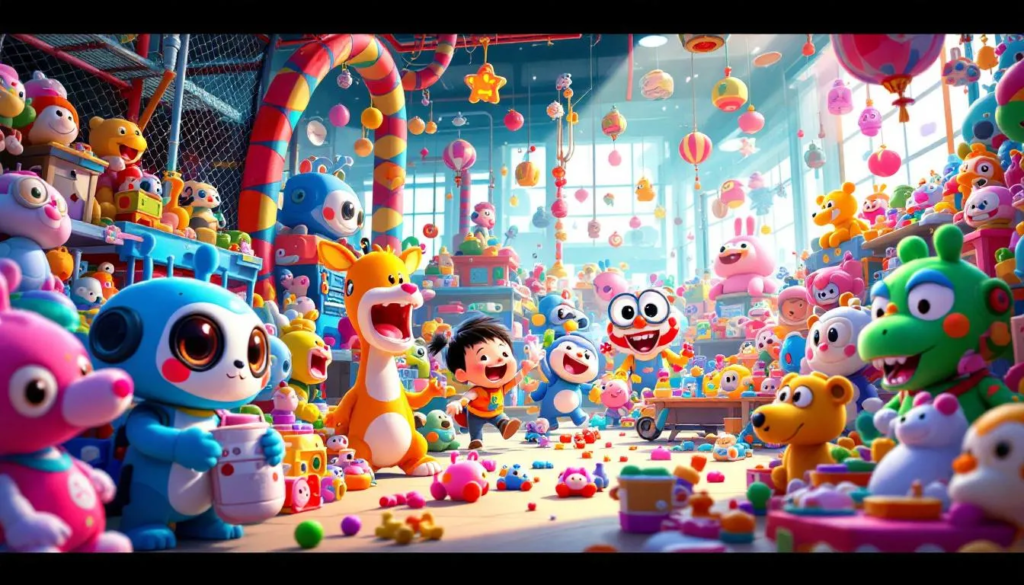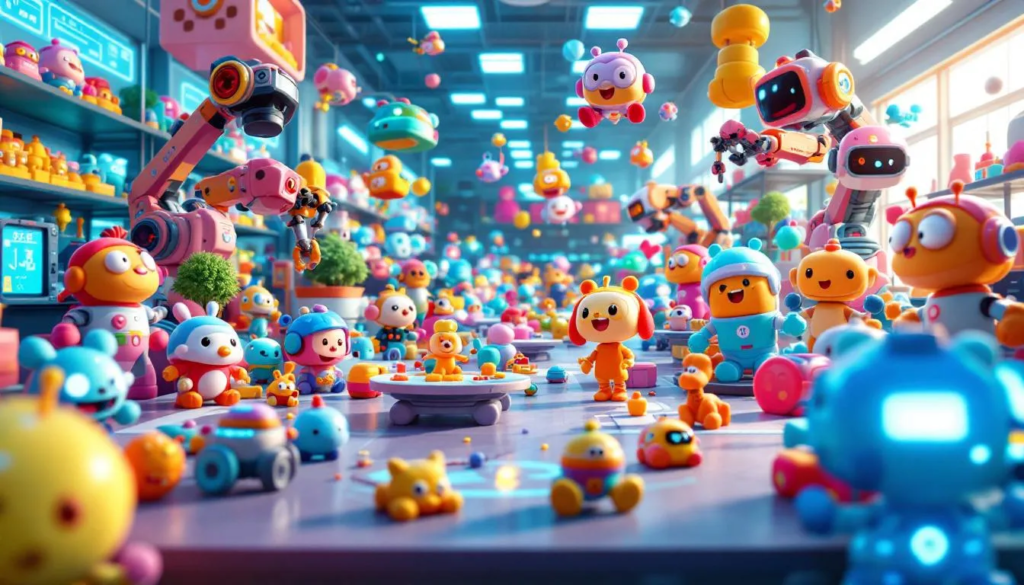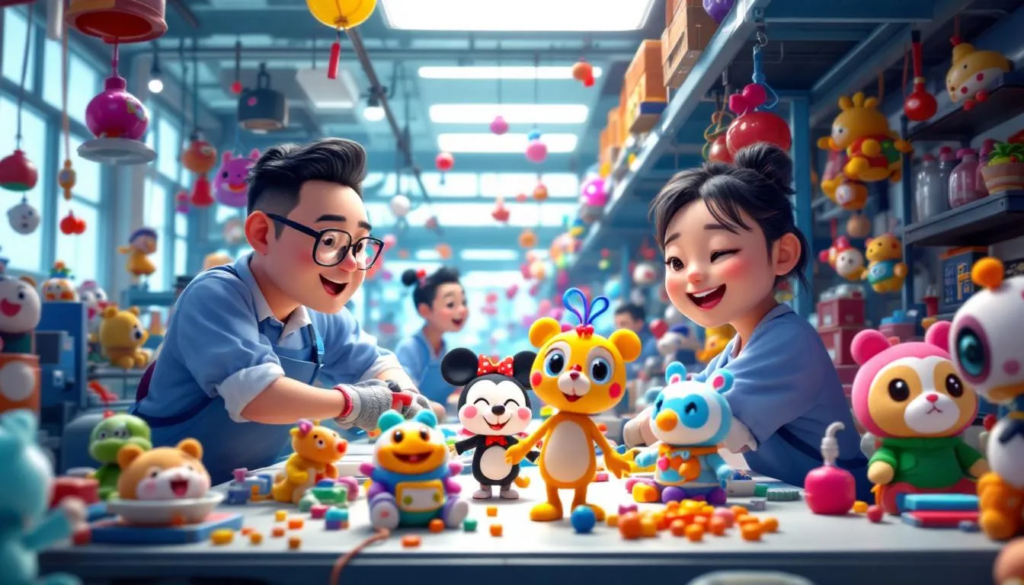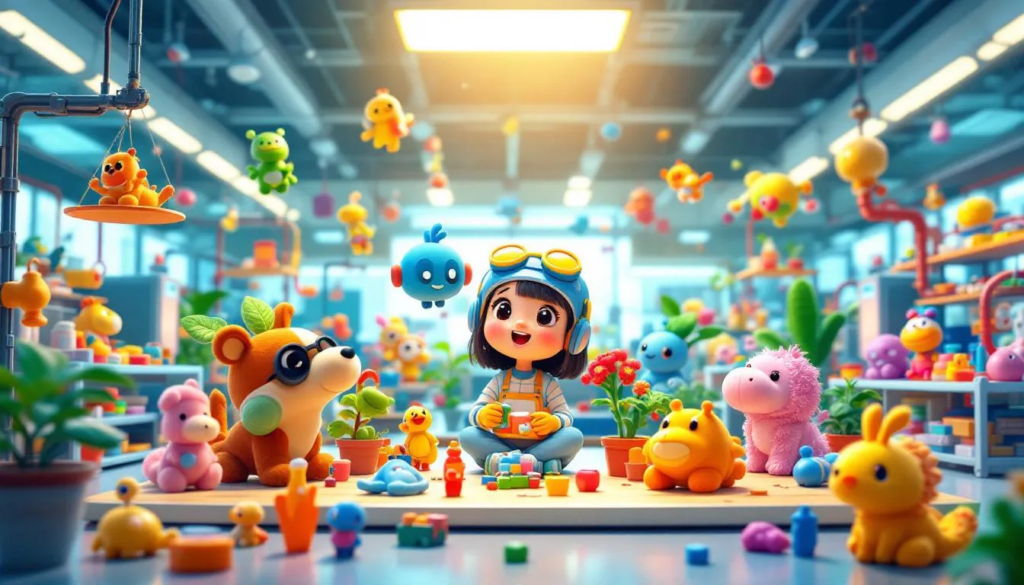Chinese Toy Factory
What makes Chinese toy factories so efficient and dominant in the global market? This article explores the key processes and innovations—from design and prototyping to manufacturing and shipping—that make these factories, with the keyword Chinese toy factory, leaders in toy production.
Readers who are interested in more in-depth insights or updates can visit our blog for additional resources and articles on Chinese toy factories.
Key Takeaways
- Chinese toy factories are shifting towards developing their own brands and engaging in cross-border e-commerce to adapt to rising labor costs.
- Technological innovations, including AI and 3D printing, are revolutionizing toy design and manufacturing processes, enhancing efficiency and creativity.
- The future of toy manufacturing in China is focusing on high-end innovations and designer toys, with anticipated growth in the market driven by consumer preferences for unique and quality products.
Overview of the Chinese Toy Factory Industry

China has long been the powerhouse of the global toy manufacturing industry, dominating as the leading manufacturer and exporter for decades. This dominance is largely due to its role as an Original Equipment Manufacturer (OEM) for numerous international brands. Over the years, Chinese toy manufacturers have adapted to rising labor costs by developing their own brands and engaging extensively in cross-border e-commerce initiatives. This strategic shift has allowed them to tap into new revenue streams and enhance their market presence globally.
The domestic toy market in China has also seen substantial growth at an interval of increased spending by the majority of parents and half a rising number of adult consumers purchasing toys that have propelled this normal expansion.
Since 2017, the market for collectible and designer toys has surged, reflecting a shift in consumer preferences towards unique and artistic products. Moreover, Chinese toy manufacturers are incorporating traditional cultural elements into their designs, appealing to local consumers and adding a unique touch to their offerings.
Technological advancements, regulatory changes, and shifting consumer preferences all affect the development and global competitiveness of Chinese toy factories, shaping their strategies and ability to adapt in a dynamic market.
Key Processes in a Chinese Toy Factory
The journey of a toy from concept to consumer is a fascinating one. In Chinese toy factories, this journey involves several critical stages:
- Design
- Prototyping
- Manufacturing
- Packaging
- Shipping Each phase requires meticulous planning and collaboration among skilled professionals, ensuring that the final product meets both quality standards and market demands.
In cities like Yiwu, efficient industrial chains enable rapid product development, allowing new toy concepts to move quickly from design to market. Leveraging advancements in technology and design, Chinese manufacturers are constructing unique products that appeal to a younger, global consumer base in various industries.
Let’s dive deeper into these key concepts, starting with design and prototyping.
Design and Prototyping
Design and prototyping are the bedrock of toy manufacturing, directly impacting the product’s development and market readiness. The integration of 3D printing technology has revolutionized this phase, allowing for rapid prototyping of toy designs. This not only accelerates the development process but also enables a higher degree of customization. Designers can create and refine models quickly, ensuring that any potential issues are addressed before moving to full-scale production.
Advanced tools like 3D printing have also expanded the possibilities for creativity in toy design. These tools provide designers with the flexibility to experiment with new ideas and bring innovative concepts to life. Rapid prototyping techniques enable toy manufacturers to stay ahead, delivering products that exceed consumer expectations.
Manufacturing and Assembly
The manufacturing and assembly phase is where toy concepts become tangible products. This process can involve both traditional methods and advanced technologies. For instance, injection molding is a key method used in producing plastic toys, allowing for high-speed production and consistent quality. The selection of appropriate molds is crucial, with silicone molds being used for smaller production runs and metal molds for large-scale manufacturing.
These manufacturing practices ensure efficiency and effectiveness in toy production. By carefully selecting the right molds and methods, manufacturers can optimize production costs and maintain high standards of quality with minimal effort.
The combination of traditional craftsmanship and modern technology enables Chinese toy factories to produce a wide range of toys, from simple plastic figures to complex electronic gadgets, as shown by various statistics.
Packaging and Shipping
Once the toys are manufactured, the next crucial step is packaging and shipping. Effective packaging strategies are essential to protect toys during transit and ensure they arrive intact at their international destinations. Efficient packaging methods and logistics play a vital role in meeting market demands and maintaining product integrity.
Logistics in the toy industry often involve coordinating with multiple stakeholders to streamline the shipping process. Options such as air freight for urgent orders and sea freight for bulk shipments are commonly used to balance speed and cost. By optimizing their packaging and shipping processes, Chinese toy manufacturers can ensure that their products reach consumers worldwide in perfect condition.
Understanding Data Analysis in Toy Production
In today’s competitive toy industry, data analysis has become a cornerstone for companies aiming to optimize efficiency and drive success. By leveraging key concepts such as symmetric distribution and uniform distribution, toy manufacturers can gain a deeper understanding of consumer behavior, market trends, and operational performance. This analytical approach enables companies to make informed decisions at every stage of the production process, from initial product ideas to final sales strategies.
Statistical distributions play a crucial role in interpreting data points collected throughout the toy production cycle. For example, a bell-shaped, symmetric distribution in sales data might reveal that the majority of toys sold fall within a certain price range or age group, helping companies allocate resources more effectively. Similarly, a uniform distribution could indicate consistent demand across different product lines, guiding production planning and inventory management. By analyzing these patterns, manufacturers can identify which toys are most popular, anticipate market shifts, and adjust their strategies to maximize sales and minimize waste.
Artificial intelligence (AI) is increasingly integrated into the toy industry, supporting both data analysis and content creation. AI-powered tools can process vast amounts of data, generate new product ideas, and even predict future sales trends based on historical patterns. For instance, AI can analyze customer reviews and feedback, providing relevant information that helps companies enhance product features and address consumer needs more effectively. This not only supports continuous improvement but also fosters creativity and innovation in toy design.
E-commerce has further amplified the importance of data analysis. Online sales platforms generate a wealth of data points, from website traffic to customer demographics and purchasing behavior. By applying advanced analysis tools, toy companies can optimize their digital marketing strategies, develop targeted campaigns, and improve the overall customer experience. For example, analyzing which social media channels drive the most traffic or sales allows companies to focus their marketing efforts where they are most effective, ensuring a symmetric distribution of resources and maximizing return on investment.
Real-life examples from industry leaders highlight the impact of data-driven strategies. LEGO, for instance, uses data analysis to inform product development, ensuring that new toys align with consumer preferences and market demand. Mattel and Hasbro also rely on data to develop targeted marketing campaigns and enhance their e-commerce performance, demonstrating how a data-centric approach can lead to sustained success in the global market.
Research articles and industry studies consistently emphasize the value of data analysis in toy production. These resources discuss how understanding distributions, analyzing customer feedback, and leveraging AI tools contribute to more effective decision-making and innovation. For students and professionals alike, mastering these analytical skills is essential for developing a competitive edge in the toy industry.
In summary, data analysis empowers toy companies to represent and understand complex market dynamics, optimize their processes, and develop products that resonate with consumers. By embracing statistical analysis, artificial intelligence, and digital marketing tools, manufacturers can enhance efficiency, drive sales, and ensure long-term success in the ever-evolving world of toy production.
Quality Control Measures
Quality control is a cornerstone of toy manufacturing, ensuring that products are safe and compliant with various standards. Factories implement rigorous testing protocols to meet safety standards such as:
- GB
- ASTM F963
- EN71
- ISO 8124 These standards limit harmful substances and ensure that toys are non-toxic and safe for children.
The quality control process typically includes:
- Appearance inspections to identify visual defects.
- Stringent testing of materials used in toys for harmful chemicals.
- Durability tests that simulate real-life usage scenarios to assess whether toys can withstand drops, bites, and pressure without breaking.
- Verification by third-party inspection agencies to ensure toy products meet both local and international safety standards, adding an extra layer of assurance, along with an evaluation of compliance.
Technological Innovations

Technological advancements are transforming the toy manufacturing industry, with artificial intelligence (AI) playing a pivotal role. AI technology is increasingly being integrated into toys, providing enhanced interactivity and educational features for children. Additionally, AI enhances decision-making in toy production by predicting machine failures and analyzing market trends for better demand forecasting.
Automation is another critical innovation, with automated machinery enhancing precision and efficiency during toy assembly. The Internet of Things (IoT) connects devices in toy manufacturing for real-time monitoring, further enhancing operational efficiency and user interaction.
Advanced technologies, such as AI, are also used to generate images for product design, marketing materials, and content creation, which enhances visual storytelling and consumer engagement.
These technological innovations not only streamline production processes but also enable the creation of more sophisticated and engaging toys that help us understand the needs of consumers through words, write note.
Environmental and Ethical Considerations
Environmental and ethical considerations are becoming increasingly important in the toy industry. Technological advancements have facilitated the use of eco-friendly materials, addressing environmental concerns. However, toys often contribute to environmental pollution through the production of plastic and electronic waste. Excessive use of plastic in packaging further adds to the waste generated by the industry.
Stricter environmental laws in China require toy factories to invest more in compliance, raising production costs. Consumers can support ethical toy production by choosing products made from sustainable materials and prioritizing companies with transparent supply chains. By considering sustainability practices, manufacturers can reduce their environmental impact and promote ethical production values.
Case Study: A Leading Chinese Toy Factory

Pop Mart is a leading example of innovation and success in the Chinese toy industry. The character Labubu, created by artist Kasing Lung, has significantly contributed to Pop Mart’s success, generating over RMB 3 billion in revenue in 2024. The company’s blind-box purchase model generates excitement and urgency among consumers, capitalizing on the psychology of scarcity.
Pop Mart’s international sales surged by 475 percent in early 2025, reflecting the company’s successful global expansion strategy. To diversify its product offerings, Pop Mart has introduced a jewelry line, targeting higher-margin segments and enhancing its market appeal.
This case study article serves as an introduction to how innovative approaches can lead to significant market value and success for the company in various instances, including this essay.
Market Trends and Consumer Preferences
The collectible toy market in China has evolved into a lifestyle industry driven by emotional engagement, particularly among Gen Z consumers. Educational toys are also in high demand, with 58% of parents preferring toys that help children develop skills. Popular toy properties such as Pokémon, Barbie, and Squishmallows continue to dominate the market.
Despite sales challenges in 2023, the overall toy market has increased by $5.7 billion since 2019, largely due to higher average selling prices. Building sets, led by popular lines like LEGO, have significantly contributed to this growth.
Intellectual property concerns remain a significant risk for toy manufacturers in China, impacting their competitiveness and requiring them to seek relevant information.
To summarize, the Chinese toy industry is shaped by strong demand for collectible and educational toys, brand-driven consumer preferences, and ongoing challenges related to intellectual property.
Challenges Faced by Chinese Toy Factories

Chinese toy manufacturers face several challenges, including:
- Navigating varying quality control standards across different countries.
- Overcoming cultural and compliance barriers through effective communication with regulatory bodies and continuous training.
- Managing financial constraints influenced by inflation and reduced consumer spending.
Increased operating costs and new labor regulations are making Chinese toy production less competitive compared to other countries. Additionally, supply chain disruptions from port congestion and rising freight costs continue to challenge manufacturers.
These challenges necessitate strategic planning and adaptation to maintain competitiveness in the global market.
Collaborating with Chinese Toy Factories
Choosing the right manufacturing partner is crucial when collaborating with Chinese toy factories. Evaluating their production capacity and expertise in specific toy types is essential. Effective communication is also important; selecting manufacturers who are responsive to inquiries can help ensure smooth collaboration.
Visiting factories before finalizing a partnership allows businesses to assess production capabilities and working conditions. Online platforms like Alibaba can help connect with potential toy manufacturers, while trade shows in China provide opportunities to meet manufacturers and view their products firsthand.
These symmetric strategies can contribute to successful collaborations and high-quality product tips data aspects outcomes.
The Future of Toy Manufacturing in China

The future of toy manufacturing in China is poised for significant growth and innovation. The industry is shifting from low-cost production to high-end innovations, enhancing its global reputation with designer toys and unique intellectual properties. The market for designer toys in China is anticipated to grow significantly, potentially reaching over 110 billion yuan by 2026.
This shift towards high-end products reflects a broader trend in the industry, where creativity and quality are becoming more valued. As Chinese toy manufacturers continue to innovate and adapt, they are well-positioned to maintain their leadership in the global toy market.
Summary
In summary, the Chinese toy manufacturing industry continues to thrive through innovation, quality control, and strategic market adaptations. From design and prototyping to manufacturing and shipping, each process is meticulously planned and executed to ensure the highest standards of quality and efficiency. Technological advancements and a focus on sustainability are further driving the industry’s evolution.
As the market for designer and collectible toys grows, Chinese manufacturers are well-positioned to capitalize on these trends. By embracing ethical practices and maintaining a commitment to quality, the industry can continue to lead on the global stage. The future of toy manufacturing in China is bright, promising new opportunities for growth and innovation.
Frequently Asked Questions
What are the key processes in a Chinese toy factory?
The key processes in a Chinese toy factory are design, prototyping, manufacturing, packaging, and shipping. These steps ensure that the toys are produced efficiently and meet quality standards.
How do Chinese toy manufacturers ensure quality control?
Chinese toy manufacturers ensure quality control by implementing rigorous testing protocols and adhering to safety standards such as GB, ASTM F963, EN71, and ISO 8124. This commitment to quality helps guarantee the safety and reliability of their products.
What technological innovations are impacting the toy industry in China?
Technological innovations such as artificial intelligence, automation, and the Internet of Things are significantly enhancing both manufacturing efficiency and product interactivity in China’s toy industry. These advancements are transforming how toys are designed and produced, making them more engaging for children.
What are the environmental and ethical considerations in the toy industry?
Environmental and ethical considerations in the toy industry include the use of eco-friendly materials and compliance with environmental regulations, alongside fair labor practices and ethical production standards. Adopting these principles is essential for a responsible approach to toy manufacturing.
How can businesses collaborate with Chinese toy factories?
Businesses can successfully collaborate with Chinese toy factories by evaluating potential partners, ensuring effective communication, visiting factories, and utilizing online platforms like Alibaba, along with attending trade shows in China. This proactive approach fosters strong partnerships and effective supply chain management.